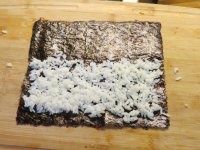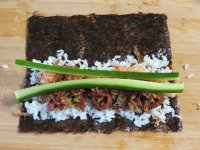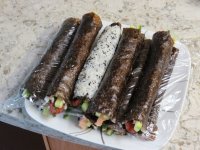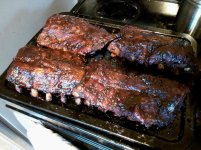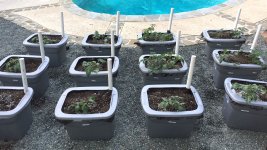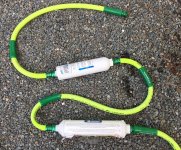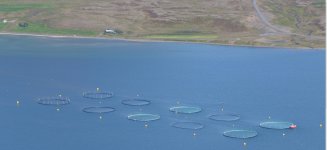Going through the cupboards today we found an unopened package of red Nori and decided it was time. Got some chinese sausage, pork floss, prawns, and an English cuke. Now we have lunch. 
Attachments
Over the weekend I set out 28 varieties of heirloom tomatoes in the garden, hoping for some kind of a half decent harvest in late summer. The back yard is a deep hole surrounded by tall redwood trees; there's only a few hours of direct sunlight. Whether tomatoes will grow and thrive and yield intensely flavored fruit: I don't know but will find out pretty soon. Regrettably there are too many deer in the front yard to put tomatoes there. Even though the sun is better.
Everything is in Self Watering Planters (big water reservoir with capillary-action "wicking" into soil), so we can take 3-day weekends away from home, not watering the tomatoes at all, without worrying that the plants will die of dehydration.
I used a total of six vendor-sold "Earthbox" planters {company link} and twelve DIY self watering planters I made from bits and pieces purchased at Walmart. Earthboxes cost about $35 each including shipping, while the DIY version uses $8 worth of materials. I built mine very similarly to {this YouTube video}, except that I added a layer of landscaping fabric before filling with potting mix. You can see this fabric in picture below: it's the black stuff poking out of the lid, in the front row of planters.
These are the DIY planters; the Earthboxes are out of frame: up and to the left. As the plants get bigger I'll space the boxes further apart. This phony-baloney arrangement is for photographic purposes only
The ones with two plants per box are cherry tomatoes; single plant per box are the tall boys of "indeterminate" height. That's tomatospeak for: it continues growing taller all summer until frost kills it. Varieties are labeled on the containers but hard to read in the photo.
_
Everything is in Self Watering Planters (big water reservoir with capillary-action "wicking" into soil), so we can take 3-day weekends away from home, not watering the tomatoes at all, without worrying that the plants will die of dehydration.
I used a total of six vendor-sold "Earthbox" planters {company link} and twelve DIY self watering planters I made from bits and pieces purchased at Walmart. Earthboxes cost about $35 each including shipping, while the DIY version uses $8 worth of materials. I built mine very similarly to {this YouTube video}, except that I added a layer of landscaping fabric before filling with potting mix. You can see this fabric in picture below: it's the black stuff poking out of the lid, in the front row of planters.
These are the DIY planters; the Earthboxes are out of frame: up and to the left. As the plants get bigger I'll space the boxes further apart. This phony-baloney arrangement is for photographic purposes only
The ones with two plants per box are cherry tomatoes; single plant per box are the tall boys of "indeterminate" height. That's tomatospeak for: it continues growing taller all summer until frost kills it. Varieties are labeled on the containers but hard to read in the photo.
_
Attachments
The back yard is a deep hole surrounded by tall redwood trees; there's only a few hours of direct sunlight. Whether tomatoes will grow and thrive and yield intensely flavored fruit: I don't know but will find out pretty soon. Regrettably there are too many deer in the front yard to put tomatoes there.
My son's back yard in Glen Ellen is pretty barren after the fires, and the wildlife which survived is pretty hungry. I suggested getting goat to control the underbrush and he remarked "Goat = No Tomatoes"
Will plant Roma, Better Boy, Brandywine and (maybe) Beef Steak in a few weeks. We have a spot which gets sun most of the day. The soil has just become workable in the last few days.
The grand-daughters wanted corn last year -- it was so cold and wet for most of the spring we couldn't even get it started.
... collecting rainwater in cisterns?
One of the founders of the World Tomato Society suggested the attached. And that's what I use.
filter #1
filter #2
~
Attachments
One of the founders of the World Tomato Society suggested the attached. And that's what I use.
What do you think about the article by Elizabeth Candelario (from your link).
Slugs can be dealt with if you have a raised bed with a surrounding support wall, two thin bare wires and a 9V battery.No slugs to contend with in the shaded backyard?
Slugs can be dealt with if you have a raised bed with a surrounding support wall, two thin bare wires and a 9V battery.
I have been thinking about that myself.
One of the founders of the World Tomato Society suggested the attached. And that's what I use.
Wow, is your water really that bad? Our water here may not be "artisanal" but you can drink from the hose and it won't kill your plants.
I have a brick built raised bed for blue berries.Slugs can be dealt with if you have a raised bed with a surrounding support wall, two thin bare wires and a 9V battery.
The slugs hide in the drainage holes and climb up through the soil.
Here in the UK we get "woolfpack" slugs.
These approach in packs of 10s or many more and get under slug guards filled with masses of slug pellets and the first few waves of the attack eat the pellets and die then the next wave climbs over them and hit the pellets and this goes on until the top ones climbing over there dead comrades get to the courgette seedling inside the guard.
The lot have to be cleared up and the pellets replaced after a few hours when there is a big attack.
Once the plants get bigger the mature stems repel the slugs and only big ones need to be picked off and dumped in the salt tray.
The guards are needed to stop the rain washing the pellets away and to protect from late frost.
Have to say for the past several years the quality of salmon has gone down the sewer, the type of feed they are served causes them to produce much less of the healthy omega 3 and more of other types of less healthy fats.
I have noticed the fat layer between the muscle layers is much thicker these days, two probable reasons are the salmon is gmo and fed with crap fodder, also when frying
The bad thing is that the pellets they feed to the salmons are made from
herrings, really not crap and a destruction of resources.
I took that photo in a western Iceland fjord last summer. If you turn around,
the area looks somewhat halfway between paradise and the land of Mordor.
Highly addictive.
cheers, Gerhard
Attachments
Last edited:
What do you think about the article by Elizabeth Candelario (from {the World Tomato Society} link)
I think the holistic farming people are onto something. I first learned of the general principle from an episode of Netflix's "Chef's Table" about Blue Hill Farm in New York state, and the head guy Dan Barber:
YouTube link to 1 minute teaser
However I myself am merely a homeowner on a small lot in the suburbs, trying to grow a few tomatoes in containers. I'm not going to bring in chickens and pigs to refertilize the soil, nor am I going to rotate crops to reinvigorate the bio-environment. Instead, I buy sterile, which is to say, STERILIZED, planting mix. I put it into STERILIZED planters, where I add measured amounts of "organic" fish meal, bone meal, earthworm castings, etc. Real Farmers with Real Farms are welcome to do whatever they wish, however they wish, at whatever level of sophistication (complexity) they wish, with my blessings and genuine hopes for spectacular success.
Me, I'm only trying to grow some good-eating tomatoes, and to hell with loftier objectives. Here's five dollars, please use it to save the planet The Right Way, while I humbly try to grow heirloom tomatoes in purchased potting-mix using purchased fertilization trickery.
Wow, is your water really that bad?\
Even if it is bad the pictures show two activated carbon cartridges, not going to do much beside make the water soft and tasty.
- Home
- Member Areas
- The Lounge
- The food thread
